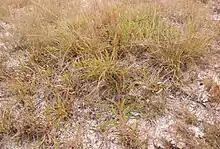Protea enervis
Protea enervis, also known as the Chimanimani sugarbush,[3] is a flowering shrub. It is native to the Chimanimani Mountains straddling Zimbabwe and Mozambique, and grows at altitudes of 1,680 to 2,000 metres.[4][5]
| Protea enervis | |
|---|---|
 | |
| Scientific classification | |
| Kingdom: | Plantae |
| Clade: | Tracheophytes |
| Clade: | Angiosperms |
| Clade: | Eudicots |
| Order: | Proteales |
| Family: | Proteaceae |
| Genus: | Protea |
| Species: | P. enervis |
| Binomial name | |
| Protea enervis | |
The inflorescence is reddish-pink in colour.[6]
Horticulture
It offers a reddish-pink flower head. It requires full sun to partial shade, and prefers a dry mesic climate. It performs best in moderately (5.6-6.0) or slightly acidic (6.1-6.5) soil.[6]
References
- Darbyshire, I.; Timberlake, J.; Dhanda, S.; Osborne, J.; Hadj-Hammou, J. (2017). "Protea enervis". IUCN Red List of Threatened Species. 2017: e.T66153870A66153875. doi:10.2305/IUCN.UK.2017-1.RLTS.T66153870A66153875.en. Retrieved 18 November 2021.
- "Protea enervis". International Plant Names Index. The Royal Botanic Gardens, Kew, Harvard University Herbaria & Libraries and Australian National Botanic Gardens. Retrieved 11 August 2020.
- "Protea enervis (Chimanimani sugarbush)". Biodiversity Explorer. Iziko - Museums of South Africa. Retrieved 11 August 2020.
- "Flora of Zimbabwe: Species information: Protea enervis". www.zimbabweflora.co.zw.
- "Flora of Mozambique: Species information: individual images: Protea enervis". www.mozambiqueflora.com.
- "Plant database entry for Protea enervis with 7 data details". garden.org.
This article is issued from Wikipedia. The text is licensed under Creative Commons - Attribution - Sharealike. Additional terms may apply for the media files.
